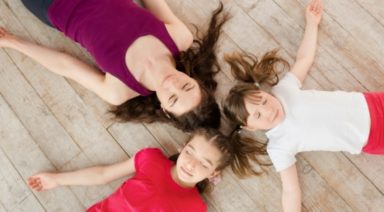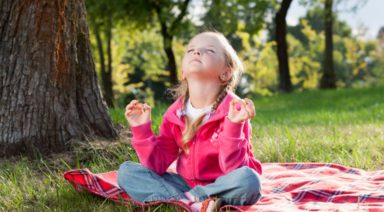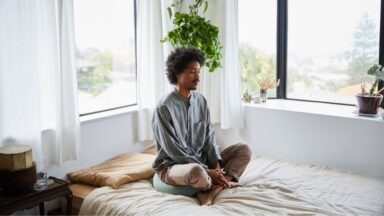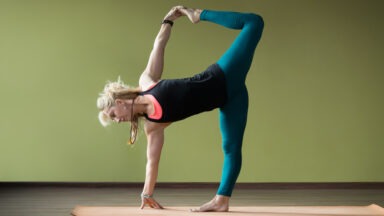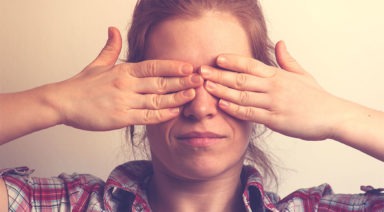How to Teach Kids Yoga

Children are overwhelmed. More than ever in my 15 years as an educator I observe our children being affected by anxiety, depression, and a host of other issues that impact learning and the ability to develop skills such as self-regulation. Yoga is an evidence-based tool to provide children with the skills to self-regulate. I see it working everyday in a variety of settings. In teaching kids yoga, I have found there are 3 vital elements needed to teach yoga to kids: a teaching philosophy, my own yoga practice, and the understanding of child development.
Genshai: Help Kids See Their Greatness
In Aspire by Kevin Hall, I fell in love with the word Genshai. It’s an ancient Hindi word meaning “never to treat others, or yourself, in a way to make them feel small.” It’s more than that, though, it’s helping people see their greatness. How does this philosophy apply to leading children’s yoga?
Amy Defillipi, a psychotherapist and yoga teacher, suggests that five positive impacts have the same affect as one negative experience on the brain. So let’s imagine a child’s day. He rides the school bus with a friend. He does well on a spelling test. He plays at recess with others. He gets called on to share in circle time. All of these events can be easily forgotten if on the bus home, no one wants to sit with him. How can we prepare the child to savor the positive experiences and allow them to sink in? How can we aim to develop children’s positive self-talk? To help the children recognize their greatness, we need to see good in ourselves.
Mind Your Self-Talk
I believe it’s a teacher’s responsibility to be kind to him/herself when working with children. Below the age of seven, children mimic what we say and do. That being the case, a teacher’s behaviors ought to be model behavior. We all make mistakes, and we all struggle. But with increased negative thoughts and words come increased instances of depression and anxiety. Is it possible for us to become so mindful of our self-talk that it would be consistent with seeing our greatness?
Challenge: Practice Genshai Toward Yourself
- Practice saying, “I love you just as you are,” as you look yourself in the mirror every day
- When something unexpected happens, pause to notice the quality of your thoughts and words. What are your thoughts and words? Once you take a deep breath or two, invite yourself to try again. Kindly respond to yourself the way you would to your childhood self. What changes?
- Write down of all the accomplishments you manage throughout the day such as exercising, making it to work, and being kind. Then when something unexpected happens, you can more easily see the big picture of all that you accomplish. Phew! Tailspin averted
- Compliment yourself for your accomplishments. If you start to talk down about yourself, stop! Refer back to number 2
It’s important to see all people as whole beings right now. Seeing children as flawed does not honor their greatness. Children should feel safe to make mistakes and exhibit a wide range of behaviors in your presence without our judgment or belittlement. In a kids yoga setting, participation will look different for all children. Be prepared to welcome a range of participation and behavior. Here are a few tips that I offer in my teacher training.
Challenge: Practice Genshai With Children
Create Clear Behavior Expectations
Small children need to know how you want them to behave. Knowing allows them to feel confident and increases the likelihood of participation. To set expectations; try simply repeating the same statements as you start class each time. If you make a practice of reminding kids that, “In yoga, we sit criss-cross apple sauce on our yoga mats”, and during class a child gets off his or her mat, you can simply ask, “where do our bodies belong during yoga class?” Question asking jogs the memory and helps bring the child back with kind inquiry. He or she will think, “Oh yea, we sit on our yoga mats,” and not, “I am bad because I left my mat.” The latter of the two thoughts can be the unintended result of a teacher getting mad when children make normal mistakes. Remember that children are dealing with constant distractors such as bodily sensations, sounds from inside or outside the classroom, seeing toys, etcetera, and therefore distraction is to be expected. Children should not be reprimanded for their mind (or body) wandering, but kindly redirected to the proper behaviors that have been clearly set. The goal of yoga and mindfulness after all, isn’t to never become distracted; it’s to return from distraction to attention with kind curiosity.
Accept Different Forms of Participation
Some children observe and listen rather than “do” yoga, especially toddlers. Some children won’t be confident or comfortable enough to practice yoga in front of other people. Forcing participation is damaging to children. Instead, verbally accept other forms of participation. For example, “some of our friends are working hard watching and listening while others are trying out the poses. Thanks for participating in your own way.” It can be tempting to emphasize ‘good yoga poses.’ Try to refrain from focusing on the physical form, but the energy and effort involved.
If a Child is Not Participating Physically, Check-In
You may hear, “Yoga is weird.” Or “Yoga is just for girls.” Acknowledge that child’s trepidations. “I thought yoga seemed weird a first, too. Now I find breathing and yoga poses calming and empowering. Do you ever want to feel more powerful?” I have seen relating to kids on this level help them relax more into learning.
Develop and Maintain Your Practice
I recommend that teachers have a regular yoga practice so they are comfortable doing yoga. You will be a better teacher if you have your own experience and know how practices feel for you and how they shift your energy. For example, you may not know that forward folds are calming until you try them and your experience may differ. Create a regular home practice, which can be as simple as adding one pose or sequence and a breath to your morning routine. I challenge you to begin a regular yoga practice. Consider sun salutations before work, or belly breathing to calm down on the commute.
Differentiate Your Practice
I have seen many skilled yogis and yoga teachers flounder in a kids yoga setting. That’s because kids yoga is different than adult yoga. That is why it’s important to study with a kids yoga expert so you learn to sequence engaging age-appropriate classes. In my Flow and Grow Kids Yoga teacher training, we encourage graduates to shadow other teachers and co-teach when they are starting out. When preparing to teach, select a few activities and rehearse them to ensure you use simple and clear language. Rehearse a few activities per week and you will have built up a repertoire of curriculum.
Understand Early Childhood development
(Infancy to Seven) According to Flower Yoga founder Tara Rachel Jones, author of It’s Time for Yoga, in early childhood, children experience the world as a one big sense organ. That means their entire body receives input from the world around them like a porous sponge. Finger-play is a tool for toddlers and preschoolers to experience a mind-body connection. The use of the fingers, toes, and skin is important because they contain neural-receptors. Tara Rachel contends, “A Finger-play is a gateway for the developing child that interconnects Head, Heart and Hands. Head: through rhythmic and imaginative language; Heart and Hands: it creates a 3 dimensional gesture that guides the articulation of the hand as a gentle helper of the heart. Furthermore, from a yogic perspective, Finger-plays are wonderful and age-appropriate precursor to a future Mudra practice (meditative hand postures that relate to positive thinking).”
Teaching Considerations
Speak slowly. Class should be 15-45 minutes. Create a familiar ritual such as ringing a chime. Include breathing activities. Be sure to ask the kids what they know about yoga and let them know what it means to you. Include a finger-play to start an imaginative journey that also includes rhythm, repetition, animals, nature, transportation, and emotions. End the yoga exploration by gradually slowing down. Ease each child into relaxation for one to three minutes. When wrapping up, ask what they enjoyed. Thank them for participating.
Yoga for Kids: Fun Finger Practice
A fun yoga practice for the kiddos to help stimulate learning. Practice this anywhere!
The Shy Turtle
Yoga Practice for Kids by Lara Hochieser
Do this finger-play several times slowly. It can be done facing one child, in a circle with a group, or with partners in a group. And remember to thank your partner or group when done!
- Say: “When turtle is feeling shy”
- Do: Hold the right fist at chest height with the turtlehead (thumb) pointing toward your center, slowly wiggling your thumb
- Say: “she/he hides in his/her shell”
- Do: Slowly open the fist one finger at a time, tuck the thumb in and close the fist the same way you opened it. Then put your hand in your lap
- Repeat the finger-play with your left hand and say “When I am feeling shy I hide in my shell”
- Say: “Come out turtle”
- Do: Bring the right fist back out with the turtle’s head out
- Repeat for the left hand
- Option to Connect deeper: Replace “turtle” with the children’s name, giving each person a turn
- Add turtle pose asana: After repeating the finger-play several times, consider adding turtle asana. Explain “Put your feet together. Wiggle your heart forward and put your head down.” While they do this, repeat, “When turtle’s feeling shy she hides in her shell.” “Come out turtle,” and sit up tall again
- Add breathing: While the children are “in their shells” ask them to take 3 slow deep breaths in and out the nose. You can count aloud for them or alternatively breathe audibly
- Memory: Ask the child what to say to help turtle come out of her shell
- Move: Turtle “walk” by scooting on the bum. Move forward and back doing turtle pose
- Imagine: Ask kids questions. At this age there is no understanding of rhetorical questions. So when you ask a question, they will shout out their answers!
- Optional questions: What color is the inside of turtle’s shell? How does turtle get to school in the morning?
- Create empathy: Ask questions to stimulate emotional literacy. Ask only one or two questions, as more can be overwhelming. “What are times it feels good to be in your shell? How do you know when to come out? Ask turtle to be your friend. What would you say?
Keep studying
My greatest sources of inspiration are the children and my teachers. The best teachers remain students. To learn kids yoga, will you sit in the seat of student?
Animal Yoga Poses for Kids
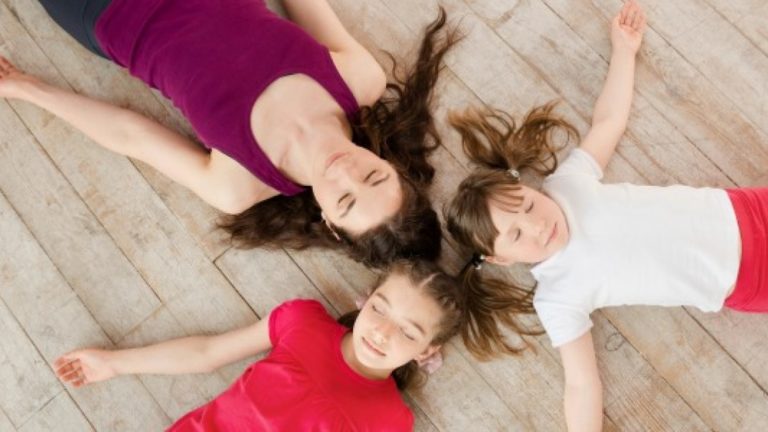
In the midst of discussing her chicken nuggets (she eats only the dinosaur shaped ones in the green box), she rolled back onto the padded window seat, bent her four-year-old knees into her little armpits and grabbed her feet. Happy Babies Pose. Gigi kept right on talking, sticking her head between her feet to look up at me with big brown in her smiling face. I marveled at my niece’s intuition and ability to move into yoga poses. At any time. And although the practice of yoga is very much a part of my life, her mom, my sister Robin, doesn’t practice yoga at all. In fact, when I asked her, Robin said Gigi had not been exposed to yoga. And yet, at four years old, she knew exactly how to move her body into many of the traditional poses.
Yoga postures, referred to as asana in Sanskrit, the language of Yoga, emulate animal shapes, elements in nature, and aspects of our surrounding world. Kids naturally create many these types of shapes with their bodies, in playful and expressive ways. My first thought was, “oh no! You shouldn’t compress the abdomen like in Happy Baby pose, mid-meal. Nor is it ideal to combine yoga and eating.” But my second thought, “Of course she’d come into Happy Baby pose, as she’s happiest when she’s eating dinosaur nuggets, the kind from the green package,” reminded me of the power of connection through yoga. Happy feeling = Happy Baby Pose.
With tools to listen and deepen our intuition, the practice of yoga connects us with our internal landscapes: breath, sensation, body awareness, and mental & physical balance. Simultaneously, yoga poses join us with our external landscapes, with the natural world and with one another. For example, when kids are encouraged to take the yoga pose of Frog, squatting with feet and knees wide, they can’t help but want to make some ‘ribbit’ sounds and hop around!
In our technology-saturated world, connection with nature, each other, and ourselves becomes an even more vital practice.
There are numerous studies on the benefits of yoga poses for kids. One such study, conducted by Kristie Patten Koenig, an assistant professor of occupational therapy at New York University, focused on elementary school kids and yoga. She and her team of researchers and teachers had the kids follow a specific routine each morning, five days a week, for 17 minutes. The routine: mats out, breathe deep, assume yoga poses, tense and relax muscles, and, finally, sing. Koenig says that yoga was effective because it seems to play to the strengths of kids (particularly those with autism), while also reducing stress. The researchers surveyed teachers at a school in the Bronx who said a daily yoga program reduced the kids’ aggressive behavior, social withdrawal and hyperactivity. “We know that anxiety fuels a lot of negative behavior, so the yoga program gives them a strategy to cope with it,” Koenig reported. “And if it’s done every morning, it becomes an integral part of the day that sets the status of the classroom and allows the kids to become calm, focused and ready to learn.”
In addition to aiding connection, yoga poses and the practices of yoga (mindfulness and breath along with movement) cultivate kids’ abilities to focus and concentrate. Yoga is increasingly being used in classrooms across the U.S. to improve the behavior and performance of kids. Additional research suggests that yoga practices help kids concentrate and focus, and improves their strength, motor coordination and social skills. Teachers report that yoga poses for kids aid in decreasing problematic behaviors.
Eight Yoga Poses for Kids
Whether you’re a teacher, parent, relative, or babysitter, kids yoga poses can be utilized in either formal teaching practice or informal play. Here are eight yoga poses for kids that can be used to enhance connection with the animal kingdom, themselves and each other. Kids can learn to welcome the sun in the morning and say goodnight to the sun in the evening, in their own yogic way.
As you’re directing kids into these shapes, allow space for their creativity and intuition to be a part of the practice. To create a deeper sense of unity and interaction, yoga mats can be placed in a circle. Use the time setting up the poses and between poses to provide information about the animal(s), their behaviors, and what we have in common with them and with each other. Allow space for both learning and play, while encouraging interaction with one other when appropriate and also the ability for each kid to connect with their own breath and sensations.

Lion Pose
- Come to hands and knees on the mat to create a table position
- Face soft to start
- Draw hips back towards heels in a pre-pounce
- Pounce forward on the mat, staying on hands and knees
- “ROAR!” sticking tongue out and looking up towards ceiling
Lion Pose is useful to teach kids to identify and manage their emotions. By linking sound and movement through the yogic practice, kids yoga poses such as Lion, create the teaching of healthy anger outlets and helps to limit emotional outbursts.

Down Dog
- Come to hands and knees on the mat in a table position
- Move hands forward one handprint
- Curl toes under
- Lift hips to the sky
- Breath work: Begin to pant with tongue hanging out, then close mouth keep the same ‘panting’ out the nose (Breath of Fire)
Down Dog Pose can be used to connect with others. Kids can take their Down Dog’s for a ‘walk’ moving off their mats and around the room, greeting other ‘Dogs’. Another option for Dog Pose in a group is to form a line of Down Dogs making a tunnel like opening beneath their bodies. One at a time, have a kid come onto their belly for Caterpillar and inch worm their way beneath the lifted Dog Poses.
Puppy Dog
- Come to hands and knees on the mat in a table position
- Walk hands forward until chest comes to the mat
- Keep arms outstretched
- Keep knees on the mat, lift ‘tail’ high
- Can make funny puppy faces, and ‘wag tails’
Puppy Dog Pose is a nice set up and/or release from Down Dog Pose. It can be used to initiate the strength to create Down Dog Pose as well as provide a softening release from it. Similarly, it can be helpful in revving up energy for Down Dog Pose (especially in a group line of Down Dogs) and bringing that same energy back down.
Caterpillar Pose
- Lay belly down on the mat
- Begin to wiggle through hips
- Either arms extended overhead or alongside hips
- Practice inching forward without using hands and feet
Cocoon Pose
- Lay either belly down or on back on the mat
- If using progression from Caterpillar to Butterfly; easier to be belly down
- Be still; unmoving
- Deep breaths
- Breath work: begin to breathe in at toes, up through legs, belly, chest, arms, throat, face and up through top of the head. Breathe out starting at top of the head, all the way back down, completing breath out from the toes

Butterfly Pose
- Lay belly down on the yoga mat
- Extend arms out to the sides
- Lift straight arms to sides of the room
- Lift straight legs to back of the room
- Can flutter arms like butterfly wings
Caterpillar, Butterfly and Cocoon/Corpse Poses linked together provide a wonderful opportunity to teach about the scientific transformation that occurs, as a caterpillar becomes an entirely different shape in the form of a butterfly. Depending on the ages of kids, you could incorporate information about how a caterpillar essentially turns to liquid in its cocoon, and then emerges as a completely different shape in butterfly.
Butterfly is another yogic shape that can be used as a pose of connection. Kids can make a circle with their mats, belly down, just less than arms distance apart. When they lift their arms, bellies connected to their mats, they can link arms with one another and fly together! Another option is to have kids emerge from Cocoon Pose onto their feet and explore ‘flying’ as butterflies to interact with one another around the room.

Childs Pose
- Kneel on mat with knees wide
- Big toes touch
- Lay belly towards mat
- Arms extended overhead
- Rest forehead on mat

Frog Pose
- Place feet wide on the mat
- Lower hips into a squat position
- Hands come to heart center
- Make ‘ribbit’ sounds
- Option to hop!
Frog Pose is another asana that can be used for interactive play. Invite kids in Frog pose to hop around and engage with one another for up to a minute. Then hop back to their mats and take Childs pose: wide knees lower on to the mat, hips back towards heels, forehead to the mat. These types of yoga poses for kids are a good practice in learning to extend energy through engagement outwards, followed immediately by pulling energy back in.
How would the world be different if our children are taught and encouraged to listen to their intuition?
If our children are supported to express their thoughts, ideas and emotions through yoga poses in a form of healthy play and self-expression? What if, rather than an alternative form of exercise that only occurred in studios, yoga became a way of communicating with ourselves, each other and the world around us?



